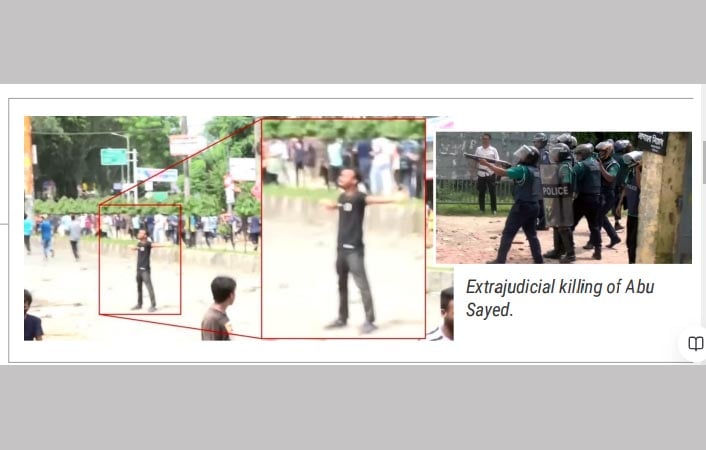News Flash
News Flash

DHAKA, Feb 13, 2025 (BSS) - Abu Sayed, a student of Begum Rokeya University, was killed by lethal metal pellets during the anti-discrimination movement on July 16 in 2024 while he was the victim of a deliberate extrajudicial killing, according to the UN fact-finding report.
"Despite the absence of a proper autopsy, the documented wounds and the related video footage support the conclusion that Abu Sayed was killed by lethal metal pellets resulting from at least two shots," the report says.
Based on the information obtained and analysed, it reveals, there were reasonable grounds to believe that Abu Sayed was the victim of a deliberate extrajudicial killing by the police.
The Office of the High Commissioner for Human Rights (OHCHR) released its Fact-Finding Report titled 'Human Rights Violations and Abuses related to the Protests of July and August 2024 in Bangladesh' yesterday (12 February).
Twenty-three-year-old Abu Sayed was the youngest among five brothers and three sisters. The first in his family to attend university, he took part in the quota movement from its very beginning.
On 16 July, thousands of school and university students demonstrated around Begum Rokeya University in Rangpur.
Tensions increased as a large group of students gathered at the University's Gate One.
According to the Police's own report to OHCHR, clashes broke out between Bangladesh Chhatra League (now banned) supporters and protesters when the protesters tried to forcefully enter through the gate of the university, and police "started firing gas shells and blank bullets to disperse the students and crowd."
The UN report mentioned that the police further stated, with respect to Abu Sayed specifically, that he was grievously injured and later died at Rangpur Medical College Hospital, with his cause of death reported as "head injury and gunshot injury."
Based on reliable and consistent victim and witness accounts and videos, OHCHR has reasonable grounds to believe direct police involvement in, and responsibility for, his killing.
In cooperation with Chhatra League supporters, police attacked students with batons and sticks. Abu Sayed was among those beaten according to witnesses. The police also fired tear gas and shotguns loaded with lethal metal pellets at the protesters. Several students were injured by the shooting, including one protester who was partially blinded, the report says.
When police started shooting at the crowd, Abu Sayed raised his hands. Videos and eyewitness testimony showed that, while he was holding a bamboo pole in one hand, he did not pose any threat to officers positioned approximately 14-15 meters away.
According to eyewitnesses interviewed by OHCHR, when he shouted at police, "shoot me," two police officers shot him multiple times with shotguns loaded with lethal metal pellets and aimed directly at his torso.
OHCHR examined publicly available videos and images of the shooting, which were originally posted on social media and enhanced by OHCHR digital forensics, to corroborate the testimonies and reconstruct how the killing occurred.
Citing a witness, the reports shows, Abu Sayed was taken to hospital where a medical professional later assessed that the pellets might have entered Abu Sayed's lungs, causing internal bleeding. OHCHR's forensic physician examined the medical records available for Abu Sayed's case and found that no proper autopsy conforming to international forensic standards had been performed.
"The physician's own examination of the medical evidence, including photos of the body, found shotgun wounds, with at least forty metal pellets on the right side of his chest and fifty on the left, including areas around the heart, lungs and abdomen."
"The forensic analysis concluded that the type and distribution of injuries were consistent with Abu Sayed having been shot at least twice with shotguns loaded with lethal metal pellets from a distance of approximately 14 meters," the UN report reads.
Forensic analysis of the video footage indicated that Abu Sayed being shot led to visible bleeding from his neck, chest, and arms, followed by signs of hypovolemia and dizziness.
The analysis found no sign of any severe head injuries that would support an alternative cause of death such as Abu Sayed's head hitting the ground while being carried away to hospital, according to the report.